Reports from the Knowledge Labs about our recent findings, research topics, and interviews with lifestyle leaders who are creating their own futures.
|
|
| |
How to stimulate your own powers of foresight. Consider the following thought provokers. Ask yourself, in these categories what are the brand new trends and forces? Which are the ones growing in importance? Which current forces are loosing their steam? Which have peaked or are reversing themselves? Which are the "wildcards" about to disrupt us in the future? POLITICAL AND TECHNICAL thought for food: Electronics, Materials, Energy, Fossil, Nuclear, Alternative, Other, Manufacturing (techniques), Agriculture, Machinery and Equipment, Distribution, Transportation (Urban, Mass, Personal, Surface, Sea, Subsurface, Space), Communication (Printed, Spoken, Interactive, Media), Computers (Information, Knowledge, Storage & Retrieval, Design, Network Resources), Post-Cold War, Third World, Conflict (Local, Regional, Global), Arms Limitation, Undeclared Wars, Terrorism, Nuclear Proliferation, Weapons of Mass Destruction, Governments (More/Less Power and Larger or Smaller Scale), Taxes, Isms: Nationalism, Regionalism, Protectionism, Populism, Cartels, Multinational Corporations, Balance of Trade, Third Party Payments, Regulations (OSHA, etc.) Environmental Impact, U.S. Prestige Abroad. SOCIAL AND ECONOMIC Food for thought:
Labor Movements, Unemployment / Employment Cycles, Recession, Employment Patterns, Work Hours / Schedules, Fringe Benefits, Management Approaches, Accounting Policies, Productivity, Energy Costs, Balance of Payments, Inflation, Taxes, Rates of Real Growth, Distribution of Wealth, Capital Availability and Costs, Reliability of Forecasts, Raw Materials, Availability and Costs, Global versus National Economy, Market versus Planned Economies, Generations: Y, X, Boomers, Elderly, Urban vs. Rural Lifestyles, Affluent vs. Poor, Neighborhoods and Communities, Planned or Organic Growth.
Got Knowledge?
|
|
| |
|
|
|
|
The Journal of 2020 Foresight
|
|
| |
|
Thursday, August 31, 2006
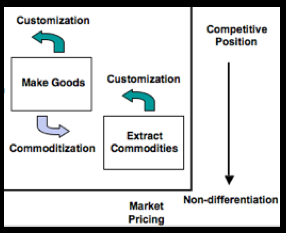
Wild West Tales and Products More Valuable Than Commodities Extracted
Chapter Four: The Tribal Territories
By Steve Howard, CKO
The Knowledge Labs
Table of Contents
Chapter One: Basecamp
Chapter Two: The Ridge
Chapter Three: The Outpost
Chapter Four: The Tribal Territories
"The flattening process relentlessly trims the fat out of business and life, but, as Ken noted, fat is what gives life taste and texture. Yes, the consumer in us wants Wal-Mart prices, with all the fat gone. But the employee in us wants a little fat left on the bone, the way Costco does it, so that it can offer health care to almost all its employees, rather than just less than half of them, as Wal-Mart does. But the shareholder in us wants Wal-Mart's profit margins, not Costco's. Yet the citizen in us wants Costco's benefits, rather than Wal-Mart's, because the difference ultimately may have to be paid for by society."
Thomas Friedman, “The World is Flat”
DOUBLE NICKEL RANCH. The history of the West– and indeed for a much longer time before the opening and closing the West in the 19th Century – is a story of living off of the land, first for self-sufficiency and then for profit in trade.
Journal of 2020 Foresight: With hindsight we can look back and see successive eras of economic development.
Explorer: Most of our journey together throughout five of the eight western states revealed local stories about how Eastern whites explored and mapped the territories unknown to them (but home to Native Americans) – as they trapped fur and became sophisticated traders.
J2020F: That’s right. The world economy sought the products of the fur trade, but the customer purchasing a beaver skinned top hat could care less how the fur, a commodity, was trapped or by whom.
Explorer: It didn’t matter if you were John Colter, Jim Bridges or Kit Carson. An undifferentiated competitive position means the market sets the price because what you offer carries no brand value, loyalty or relevance to the ultimate customer.
J2020F: And, wasn’t the market price set in St. Louis?
Explorer: The fur trade put St. Louis on the map – literally. The trappers and traders exchanged pelts there, but as an outpost for the east coast and European aristocracy, St. Louis established the prices. Which became even more painful for trappers when silkworms replaced beaver pelts as “the thing to buy” in top hats and the bottom fell out of the fur trade market around the 1840s.
J2020F: Almost fifty years later, didn’t Buffalo Bill Cody sense his life straddled a “customized – commoditized” economic era?
Explorer: Yes. His Wild West show toured for three decades throughout the United States and Europe once he realized how to stage tall tales and the mythology of the western experience.
J2020F: One of the ironies was his troupe of entertainers relied on the railroads and other turn of the century industrial inventions to travel efficiently from one venue to the next.
Explorer: The industrial revolution put the West out of business. And, yet he sensed that his audiences hungered for the experience that could be no more.
J2020F: He made a better living at the higher end of the premium priced, customer-relevant, highly differentiated value chain glamorizing what was in reality a hard scrabble way of life scratching the dirt for an undifferentiated commodity, usually extracted from the ground, grown in the ground as in agriculture or raised above it as on cattle ranches, for instance.
Explorer: Throughout Colorado, Nevada and California extracting commodities in the mid-1800s provided prospectors and miners a living, but by mixing and processing commodities, the higher priced offering moved up the value-chain to those making the goods from the metals mined.
J2020F: They could charge a higher price and make a higher margin on what they produced.
Explorer: It was something Mark Twain experienced and wrote about in “Roughing It” as the first “Trapped and Permanently Temporary” drifter trying to strike it rich in gold and silver, but instead found a more valuable profession by spinning yarns and reporting about others like himself in booming Virginia City, Nevada.
J2020F: In severe cases entire communities, just like the 550 mining ghost towns in the Sierras, that couldn't adjust found themselves unable to compete on the world stage.
Got Knowledge?
Copyright ©2002 - 2006 Aarnaes Howard Associates. All rights reserved worldwide.
6:56 AM
Wednesday, August 30, 2006
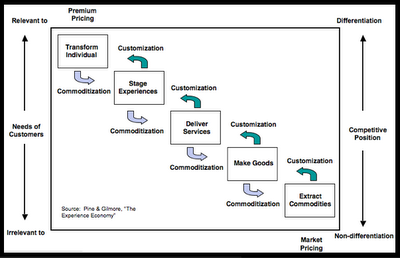
Customize Before You’re Commoditized: Premium, Differentiated and Relevant
Chapter Four: The Tribal Territories
By Steve Howard, CKO
The Knowledge Labs
Table of Contents
Chapter One: Basecamp
Chapter Two: The Ridge
Chapter Three: The Outpost
Chapter Four: The Tribal Territories
"'While we sympathize with any grieving family, Yahoo! accounts and any contents therein are nontransferable' even after death, Karen Mahon, a Yahoo! spokeswoman told the AP. As we get rid of more and more paper and communicate through more and more digitized formats, you better sort out before you die, and include in your will, to whom, if anyone, you want to leave your bits. This is very real. I stored many chapters of this book in my AOL account, feeling it would be safest in cyberspace. If something had happened to me during my writing, my family and publisher would have had to sue AOL to try to get this text. Somebody, please, sort all this out."
Thomas Friedman, “The World is Flat”
DOUBLE NICKEL RANCH. The rules of the game have dramatically changed. Finding your sweet spot -- the best fit for you based upon the divergent or convergent requirements for a particular phase of organizational growth, the economic or business cycle it operates in and your talents and abilities -- is one thing. A whole other trend towards relentless commoditization now practiced globally is quite another.
Journal of 2020 Foresight: The significant challenge facing the unique blend of talent tribes tasked with reinventing their corporation is – reinventing it as what? Where can they find a new niche capable of generating the kinds of margins and growth opportunities required to sustain and grow the mature business?
Explorer: Agents worldwide, now – not just in the U.S. – keep on introducing disruptive technologies that when combined with lower overhead operations suck the margins out of what used to be very profitable businesses.
J2020F: So what can reinvention teams do who witness their bread and butter products becoming a commodity?
Explorer: What we’re really saying is you have to keep one eye on what is relevant to the needs of your customers or your organization's customers and another on the differentiation of your competitive position from everyone else in your industry – or else.
J2020F: Or else you are road kill?
Explorer: Yup. Here's a clue that has to do with broad trends in the marketplace to help reinvention teams determine a new direction – or for a way for you in your career to regain your marketability if you’re looking for a job.
J2020F: Bring it on.
Explorer: Obviously the best competitive position is to be highly differentiated and highly relevant to your best customers' needs so you can charge premium prices.
J2020F: You’ve got my attention because, if the marketplace forces me to keep cutting costs and prices, how can I stay in business? Go on.
Explorer: While the whole secret to success in each stage of an organization's growth is the interplay between divergent loosening and convergent tightening, so too do we see an interplay.
J2020F: And it is?
Explorer: This time it is between the commoditization of your offering while you customize your next – as has been happening since prosuming hunters and gatherers traded for what they needed and then cultivated crops and mined metals out of the round earth.
J2020F: And that is the story we encountered throughout our journey West embodied in the Hudson’s Bay Company history over hundreds of years.
Explorer: That’s right. They “stepped up” to the next higher margin offering by customizing or personalizing what they had been selling successfully as one era ended and the next emerged.
J2020F: As did some of the fur trappers and Mark Twain?
Got Knowledge?
Copyright ©2002 - 2006 Aarnaes Howard Associates. All rights reserved worldwide.
6:22 AM
Tuesday, August 29, 2006
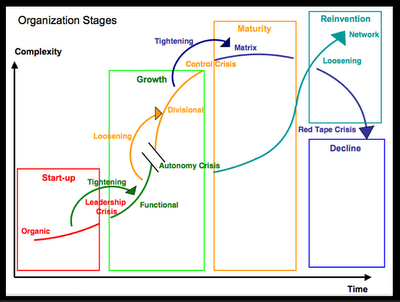
Every Organization Has a Stage, Pick the Right Cast for the Next Act
Chapter Four: The Tribal Territories
By Steve Howard, CKO
The Knowledge Labs
Table of Contents
Chapter One: Basecamp
Chapter Two: The Ridge
Chapter Three: The Outpost
Chapter Four: The Tribal Territories
"Something else is absolutely going to have to be sorted out in a flat world: Who owns what? How do we build legal barriers to protect an innovator's intellectual property so he or she can reap its financial benefits and plow those profits into a new invention? And from the other side, how do we keep walls low enough so that we encourage the sharing of intellectual property, which is required more and more to do cutting-edge innovation?"
Thomas Friedman, “The World is Flat“
DOUBLE NICKEL RANCH. Armed with the knowledge that whatever has worked in the previous phase of an organization’s growth is exactly 180 degrees opposite of what is required for success in the next phase, you can sell your value proposition confidently.
Journal of 2020 Foresight: If we revisit the bell-shaped curve again for a moment, is there some sort of short-hand way of sizing up needs of a potential employer, client or customer from a distance – some sort of educated guess?
Explorer: You bet there is cyclical expansion or contraction periods. Moving back and forth between loosening and tightening of controls and between divergent and convergent management practices.
J2020F: Tied to economic cycles? They can come and go regardless of what state an organization is currently in, right?
Explorer: Sure. We see cyclical swings back and forth between diversification and consolidation.
J2020F: I'm guessing as the economic cycle contracts the organization consolidates its product offerings, while they diversify their product line when it expands.
Explorer: That's true. Each of the typical turning points between innovation and efficiency, or between expansion and contraction corresponds to a loosening divergent or a tightening convergent organization strategy.
J2020F: Divergent in what way?
Explorer: Usually away from a structured, centralized, or coordinated organization structure and decision-making approach.
J2020F: To what?
Explorer: Towards a more unstructured, decentralized hierarchy designed to deal with the competitive environment changes and increased complexity. This is the innovation-driven, adaptive period.
J2020F: And the opposite?
Explorer: The reverse begins with a convergence away from an autonomous organization and decision-making process and moves to a more coordinated, centralized structure -- designed to economize on scarce resources.
J2020F: This same kind of divergence to convergence and visa versa occurs even independent of economic or market conditions, right?
Explorer: Let's recap. The start-up phase favored by Agents is an organic, creative and collaborative phase that ends in a crisis of leadership.
J2020F: The ticket to the next stage is management -- a tightening or convergent approach -- just the opposite of the first and favored by a combination of Agents and Athletes.
Explorer: But when a functional organization reaches its end state it is a crisis or autonomy that requires a loosening approach found in divisional structures, favored by Athletes and Associates.
J2020F: When the strength of the divisional organization over extends it reaches a limit and a crisis of control requiring a tightening approach ends in a matrix -- structure favored by Associates and Academics.
Explorer: But that runs its course in a red tape crisis requiring a loosening network organizational structure, favored by unique combinations of Academics and Agents.
J2020F: And by learning lessons from the core competencies assembled from Agents, Athletes, Associates and Academics to pull off a reinvention strategy organization masters the timing of shifting from loosening or divergent approaches to convergent or tightening approaches to divergent and loosening again with less resistance.
Explorer: The most difficult lesson is to begin the reinvention efforts during a time when major growth dominates the collective mindshare and budgeted resources among Athletes and Associates but before Agents are about to depart to prevent major shock to the organization’s system further down the path.
J2020F: But, let's say I'm the Chief Reinvention Officer for my organization, on this flat earth with relentless commodization, how do I pull a rabbit out of the hat?
Got Knowledge?
Copyright ©2002 - 2006 Aarnaes Howard Associates. All rights reserved worldwide.
6:35 AM
Monday, August 28, 2006
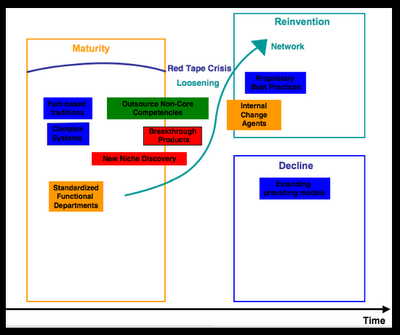
Internal Change Agents: Not Too Tan, Not Too Red to Reinvent on a Flat Earth
Chapter Four: The Tribal Territories
By Steve Howard, CKO
The Knowledge Labs
Table of Contents
Chapter One: Basecamp
Chapter Two: The Ridge
Chapter Three: The Outpost
Chapter Four: The Tribal Territories
"As you sort out and weigh your multiple identities -- consumer, employee, citizen, taxpayer, shareholder -- you have to decide. So you prefer the Wal-Mart approach or the Costco approach? This is going to be an important political issue in a flat world: Just how flat do you want corporations to be when you factor in all your identities? Because when you take the middleman out of business, when you totally flatten your supply chain, you also take a certain element of humanity out of life."
Thomas Friedman, “The World is Flat”
DOUBLE NICKEL RANCH. So, bottom line – this is all about finding the best fit for you in the same or different geographical location. You can target one of four types of organizations. Or one or two phases in an organization’s growth that fit you best in a way that increases your career equity and marketability.
Journal of 2020 Foresight: We began these series of discussions about the second half of a different model – the “right hemisphere” which is all about “Work Life.”
Explorer: That’s right. Both you and Eagle described how to do what you love and how to future-proof your life plans.
J2020F: All about what we’d call the “left hemisphere” described as the extended Boomer family making decisions about life, love and quality of life communities.
Explorer: Of the four scenarios you described, the most disturbing as a future for Boomers was the “Trapped and Permanently Temporary.” The decision boiled down to finding the right fit for employment in the same or a different location.
J2020F: That’s true. No matter where you look in a geographical area, if you know which stages of growth – start-up, rapid growth, sustained growth, maturity and decline or reinvention-- appeal to your strengths and you can determine which phase a new employer, client or customer is in or about to begin, you will find the right fit.
Explorer: The trick to working for others boils down to a matter of understanding if you fit in one of the Agent, Athlete, Associate or Academic tribal communities. What’s more important to you – a fast pace or a methodical pace? Can you become a loyal company man or woman, or do you crave independence?
J2020F: Then what do you do about it?
Explorer: If you are more of an Agent – then you’ll shine in the start-up phase and in the initial stage of emerging growth. Depending upon the degree of affiliation you require – you may discover that you have a flair for intrepreneuring or collaborating with change agents in the reinvention stage.
J2020F: Or you may want to pursue the lone eagle path to join a rapid-prototyping or an R&D outfit, a think tank or a commercial product laboratory in a pristine or resort community.
Explorer: I think that the most difficult choice is for former Academics – those overly specialized professionals who get caught in the reductions in force from mature organizations spiraling into a decline. They make up the ranks of Interim Middle Managers, those Starting Over or the Portfolio Professionals and Digitally Mobile looking for a new job.
J2020F: Their contribution, that keeps them employed along the reinvention path, is harvesting proprietary best practices generated from a skunk works, right?
Explorer: True. They tend to take on more entrepreneurial Athletic characteristics and thrive on the loosened organizational structure – more so than their more traditional Academic counterparts.
J2020F: Don’t they have a lot in common with the Athletes, who share Academic characteristics?
Explorer: They do, because decisions have to be made about what to keep and what to throw out – or outsource to suppliers.
J2020F: And, to have the systems in place to monitor the supply chain and partnerships required to produce products and services efficiently.
Explorer: But the glue that holds the reinvention path together comes from the Associate-Agents who become internal change agents. They have to thoroughly and intimately understand the old culture – where the points of major resistance lie and how to interpret new niche discoveries and their resultant breakthrough products in a way that the status-quo advocates accept in the time required.
J2020F: I guess if I were a new executive in my first one hundred days, I’d want to match my leadership style to the needs of the organization. What are my options?
Explorer: Well you have four options depending upon if you conclude you have the time to revitalize or renew or need to take more direct action to restructure or realign. For larger organizations you’ll want to develop a reinvention capacity before you need it so you can cause your major competitor to react to you rather than the other way around.
J2020F: Since every organization has a stage, all I'd have to do is pick the right cast for the next act, right?
Got Knowledge?
Copyright ©2002 - 2006 Aarnaes Howard Associates. All rights reserved worldwide.
7:21 AM
Sunday, August 27, 2006

Reinvention Chef: Mixing the Right Talent Ingredients in Recipe for Growth
Chapter Four: The Tribal Territories
By Steve Howard, CKO
The Knowledge Labs
Table of Contents
Chapter One: Basecamp
Chapter Two: The Ridge
Chapter Three: The Outpost
Chapter Four: The Tribal Territories
"On December 7, 2004, IBM announced that it was selling its whole Personal Computing Division to the Chinese computer company Lenovo.... Talk about horizontal value creation: this new Chinese-owned computer company headquartered in New York with factories in Raleigh and Beijing will have a Chinese chairman, an American CEO, an American CPO, and a Chinese CFO, and it will be listed on the Hong Kong stock exchange. Would you call this an American company? A Chinese company? To which country will Lenovo feel most attached? Or will it just see itself sort of floating above a flat earth?"
Thomas Friedman, “The World is Flat”
DOUBLE NICKEL RANCH. It’s one thing to force the “jump to a winning reinvention path” through a major restructuring of people, processes, technologies and organization rearrangement. It’s quite another to develop the competency in-house to do it over and over again as needed.
J2020F: You’d think that mature organizations want to prevent the total disruption restructuring brings by acting at an earlier time. Is it that the emotional commitment is not sufficient to overcome the resistance to change?
Explorer: Yes. Recognizing the external signals of impending decline and acting on them requires foresight. Mature organizations excel at hindsight. So recognition and execution usually only occur after it is too late to mobilize in time to avoid a decline.
J2020F: Why?
Explorer: Like a lot of things, we’re really talking about 5 percent analysis -- finding out what has to be done-- and 95 percent of time and effort creating a demand for and executing change.
J2020F: It seems logical that the more time a mature organization operates with the “Red Tape” mentality, the longer it takes them – years even -- to shed their old habits and acquire a different set of competencies?
Explorer: Think of it as a chef would in a gourmet contest. The recipe requires four parts Academic, two parts Associate, two parts Agent and part Athlete.
J2020F: But, the active ingredients that account for the winning flavor are four parts Academic? I find that hard to believe.
Explorer: No, they’ve lost their power at this stage to the unique blends of ingredients missing from their shelf. They have too much of a vested interest in mastery – slowly building an expertise of embodied knowledge.
J2020F: So they become highly resistive to change?
Explorer: Yes. To changes in demand for the systems they built and the organizational structures they maintain. They create unintended consequences by professionalizing every function, and then having every function optimize their own processes and procedures according to external professional standards.
J2020F: How so?
Explorer: The mature organization’s system of professional functions
– each competing for more budget and influence according to their profession’s standards sub-optimizes the enterprise’s capability to respond to dramatic shifts in their market, industry and customer base.
J2020F: To change metaphors, if you add an “i” to Chef, you get “Chief”. So, in reinvention stages what you’re telling me is a new talent tribe is required – something that most organizations don’t have in house, or if they do not in great supply?
Explorer: That’s right. To change metaphors again, what you need to “make or buy” is a Donnie and Marie combination of talent.
J2020F: Huh?
Explorer: You know, a little bit country and a little bit rock and roll. A cross-talent team drawn from Agents, Athletes, Associates and Academics – but found closer to the center of the model where innovation and knowledge intersect – more adaptive and flexible than their counterparts on the outer ring. If you have time you can grow your own, if not you must recruit or acquire them.
J2020F: Not exactly disruptive innovators and against-all-odds marketing teams, but rather a mix of internal change agents and knowledge managers is what you’re after to reinvent the enterprise and breathe new life into old procedures and processes relevant as the newer proprietary best practices – right?
Explorer: You’ve got it! You need Agent-Associates (“R&D Laboratories”) producing breakthrough products; Athlete-Academics (“Operational Excellents”) to improve operations and outsource non-core competencies; Associate – Agents (“Internal Change Agents”) to create the demand for change and to execute strategies to minimize resistance; and finally that unique combination of Academic- Athletes (“Professional Practice”) to capture and embody proprietary best practices.
J2020F: Wait a minute. According to this model the combinations you just described lie along the path of highest resistance.
Explorer: Yes, that’s right. Usually those combinations represent polar opposites in identity and pace and that’s why no others can master the reinvention process in the inner circle.
Got Knowledge?
Copyright ©2002 - 2006 Aarnaes Howard Associates. All rights reserved worldwide.
5:45 PM
Saturday, August 26, 2006
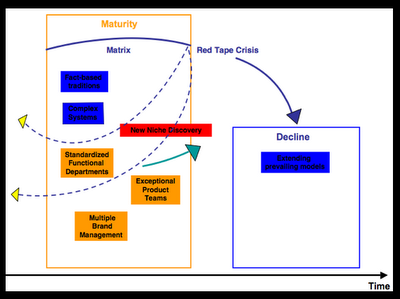
Avoiding Red Tape Decline for Crash-Test Dummies
Chapter Four: The Tribal Territories
By Steve Howard, CKO
The Knowledge Labs
Table of Contents
Chapter One: Basecamp
Chapter Two: The Ridge
Chapter Three: The Outpost
Chapter Four: The Tribal Territories
"It is this triple convergence -- of new players, on a new playing field, developing new processes and habits for horizontal collaboration -- that I believe is the most important force shaping global economies and politics in the early twenty-first century. Giving so many people access to all these tools of collaboration, along with the ability through search engines and the Web to access billions of pages of raw information, ensures that the next generation of innovations will come from all over Planet Earth. The scale of the global community that is soon going to be able to participate in all sorts of discovery and innovation is something the world has simply never seen before."
Thomas L. Friedman, “The World is Flat”
DOUBLE NICKEL RANCH. Mature organizations have vested interests in the way things were. While not overtly describing themselves as status quo advocates, many long-time Associates and Academics resist disruptive changes required to “jump paths” out of a declining trajectory.
Journal of 2020 Foresight: So, this is yet again a classic pattern. What brought you to the dance, practiced too much precludes you from learning the new steps that the audience now craves.
Explorer: Or if all you have in your toolbox is a hammer, every problem looks like a nail.
J2020F: What we’re talking about sounds a lot like what Trailblazer called the Old Game Strategy, an organization's response is to resist, so they don't initiate any internal changes. They believe that they can still be successful depending upon their ability to contain the change forces.
Explorer: That’s what they hope as they assume the ostrich position. But as anyone knows who has taken a popular change management class, abrupt change triggers a more radical disruption. And that gut-wrenching crisis forces everyone to accommodate it to survive, whether they want to or not.
Explorer: In reality, what is required is rapid, focused, specific change. As always with discontinuous change, there are severe limits to the change in behavior and beliefs that can be accomplished in the time available.
J2020F: Trailblazer says that companies often in a reinvention situation are there because they were unable to respond early when the forces of change were weaker.
Explorer: That’s right. And, the excessive tightening with the matrix organization in the mature stage that overcame divisional looseness, sets the stage for more trouble.
J2020F: The next major bonking?
Explorer: Yes, only this time the bonking is more like the car crash test of those safety dummies into the wall, but without their seatbelts fashioned.
J2020F: Or, driving down the street in your SUV and falling into a huge hole, again?
Explorer: Instead of taking a different street – in a hybrid vehicle – embracing the loosening required and the foresight to capitalize on a new niche.
J2020F: To break out of Red Tape Crisis requires the acquisition of or the return of the last two “red” Agent innovator tribes -- “Thought Leaders” and the Product Leader “R&D Laboratories” who produce new niche breakthrough products, right?
Explorer: Exactly. They’re the masters of collaboration tools and they participate in all sorts of discovery and innovation through their worldwide web-like networks.
Got Knowledge?
Copyright ©2002 - 2006 Aarnaes Howard Associates. All rights reserved worldwide.
9:12 AM
Friday, August 25, 2006
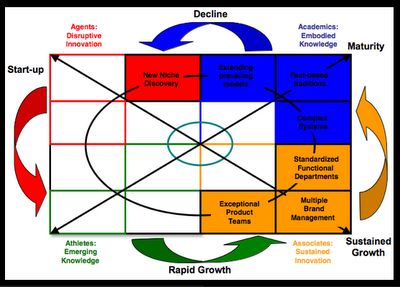
Injecting Disruptive Reds: The Art of Skipping Tracks to the Inner Circle
Chapter Four: The Tribal Territories
By Steve Howard, CKO
The Knowledge Labs
Table of Contents
Chapter One: Basecamp
Chapter Two: The Ridge
Chapter Three: The Outpost
Chapter Four: The Tribal Territories
"The old voice platform (phone) did not lend itself well to innovation. But when you put voice on an Internet platform, all sorts of innovative options for collaboration become possible.... Companies will compete over SoIP (services over the Internet protocol); who can offer you the best videoconferencing while you are talking over your computer, PDA or laptop; who can enable you to talk to someone while easily inviting a third or fourth person into the conversation; who can enable you to talk and swap document files and send text messages at the same time, so you can actually speak and work on a document together while talking."
Thomas L. Friedman, “The World is Flat”
DOUBLE NICKEL RANCH. The prescription for decline, usually purchased during advanced stages of the “Mature Matrix” disease, is to bring in a new management discipline and the talent that can re-capture breakthrough product innovations while outsourcing non-core competencies.
Journal of 2020 Foresight: It looks like as we follow the path of least resistance around the edges of our Agent, Athlete, Associate and Academic model, we come full circle to the red quadrant.
Explorer: Yes. By now the original two Agent talent tribes, the “Breakpoint Inventors” and “Commercial Innovators” vacated the premises a stage or two ago. And, most likely three of the four types of Athletes “Marketing Athletes,” “Resilient Project Teams” and “Core Business Groups” followed them out the door, but at later dates.
J2020F: Is it probable that the “square” along the bottom of our chart is vulnerable as well?
Explorer: Highly probable. The “border” Associate sub-talent tribe, the “Agile Tiger Teams” next to the Athletes – who introduced exceptional products when rapid growth got too out of hand – are indeed next in line to look for better opportunities.
J2020F: I find it highly improbable that you will entice any of the disruptively innovative agents or the rapidly prototyping Agent-Athletes back into the fold, so the model breaks down here, doesn’t it?
Explorer: Actually, it dives straight down and circles like a spiral from left to right, as you’ll see a little later. Agents? Yes, but a special kind of Agent and that’s not all.
J2020F: So, with the exception of returning to our “starting red square” we completed the squares connected to the “outer black circle” in our model. Can we pull out of the Decline?
Explorer: Yes, but if the organization continues to extend what they’ve always done, but get much better at doing it they fall victim to what Joel Barker calls paradigm blindness.
J2020F: Oh, not the “P” word!
Explorer: I know. It’s similar to phenomenon Danny Miller wrote about – how an over-extended strength becomes a fatal flaw. The point is the organization can’t see what is necessary to pull out of its decline. And the longer it takes for leaders of the organization to recognize that they are on the path to disaster, the more disruptive the solution becomes.
J2020F: So, you’re saying that it takes a new path beginning with a new niche discovery and into the inner circle to recover in time to grow?
Explorer: Exactly. And timing is everything!
J2020F: Or what, you decline into a sea of red tape?
Got Knowledge?
Copyright ©2002 - 2006 Aarnaes Howard Associates. All rights reserved worldwide.
7:43 AM
Thursday, August 24, 2006
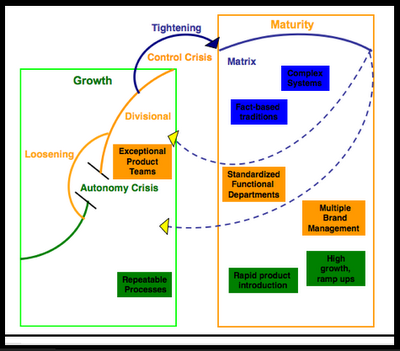
The Matrix: Tightening and Controlling Complexity with Expert Systems
Chapter Four: The Tribal Territories
By Steve Howard, CKO
The Knowledge Labs
Table of Contents
Chapter One: Basecamp
Chapter Two: The Ridge
Chapter Three: The Outpost
Chapter Four: The Tribal Territories
"'In this world you better do it right -- you don't get to pick up and move to the next town so easily,' said Dov Seidman, who runs a legal compliance and business ethics consulting firm, LRN. 'In the world of Google, your reputation will follow you and precede you on your next stop. It gets there before you do....'"
Thomas L. Friedman, "The World is Flat"
DOUBLE NICKEL RANCH. Agents faced their “Leadership Crisis” by recruiting Athletes to bridge the gap between organic and functional structures. Athletes bridged the “Autonomy Crisis” by loosening what Athletes tightened with the assistance from Associates. The resulting divisional structure eventually outlasts its usefulness when it triggers the “Control Crisis” that Academics help bridge by tightening and centralizing operations in a complicated matrix structure featuring data-driven methods and systems.
Journal of 2020 Foresight: As more functional departments proliferate the Agents disappear, not fitting into cultures built to reward affiliation and mastery. And, the days of the maverick, do-what-ever-it-takes team loyalty -- highly rewarded for fire-fighting heroics become numbered. What contributes to the Athlete-unfriendly culture?
Explorer: They don’t appreciate becoming “just a number.” With growing maturity, size and complexity dictate that the “new market athletes” leave in favor of the complex system specialists and their emphasis on fact-based decision making and problem solving throughout the enterprise. Just as the diagonal line between Agent and Associate identifies the path of highest resistance, so to does the line from Embodied Knowledge (Academics) to Emerging Knowledge (Athletes).
J2020F: This is the time of transition from a purely Associate to a more Academic organization?
Explorer: Yes, The “tightening bridge” provides a path from divisional “redundancies” brought about by local decisions to complicated central control offering efficient deployment of resources throughout the enterprise.
J2020F: So, by following the path of least resistance, the organization begins to tilt in favor of professionals often certified by “Traditional Institutions” in the methods of managing complex systems and advised by “Brand-As-Experts about best practices on the other side of “the border” from Associate “Analytical Specialists?”
Explorer: Yes. But as in all things in life, too much of a good thing over long periods of time -- over “professionalization” without the innovators or the go-to-marketers -- sets the conditions for decline as former loyal customers sense it’s time to move on, as well.
J2020F: Why?
Explorer: At this stage of development most of the focus by the organization is on inside operations and not enough on customers – their care and feeding. It’s as if the customers – frequently in large numbers – are taken for granted.
J2020F: And that sets up yet another opportunity to bonk?
Explorer: You bet, as we will see.
Got Knowledge?
Copyright ©2002 - 2006 Aarnaes Howard Associates. All rights reserved worldwide.
6:48 AM
Wednesday, August 23, 2006
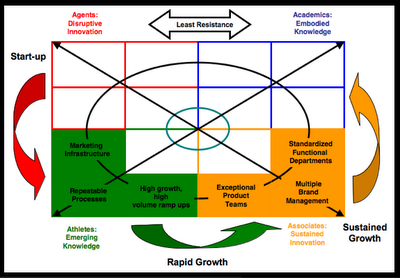
Associates Multiply and Agents Leave Divisions for Redder Pastures
Chapter Four: The Tribal Territories
By Steve Howard, CKO
The Knowledge Labs
Table of Contents
Chapter One: Basecamp
Chapter Two: The Ridge
Chapter Three: The Outpost
Chapter Four: The Tribal Territories
"There is no sugar-coating this: in a flat world, every individual is going to have to run a little faster if he or she wants to advance his or her standard of living. When I was growing up, my parents used to say to me, ‘Tom, finish your dinner -- people in China are starving.’ But after sailing to the edges of the flat world for a year, I am now telling my own daughters, ‘Girls, finish your homework -- people in China and India are starving for your jobs.'"
Thomas L. Friedman, “The World is Flat”
DOUBLE NICKEL RANCH. To mature and survive, an organizational brand needs to be accepted ideally by the majority of the total available market. Associates maintain that reputation. The optimal mix favors a growing Associate and Athlete talent blend, while the Agent tribal members feel devalued by the shift in emphasis.
Journal of 2020 Foresight: That's why a loyal, affiliated talent culture is needed?
Explorer: Yes, through their behaviors they develop a trust mark that keeps bringing long-term customers back again and again. “Agile Tiger Teams”, “Loyal Survivalists” and” Analytical Specialists” gain in political stature.
J2020F: So as we follow our path of least resistance around the outside ring in our model and then turn the second corner, you’re saying the power shifts once again?
Explorer: Yes, in the same way that “Marketing Athletes,” Resilient Project Teams,” and “Core Business Groups did while the start-up Agents lost clout. The sequence moves from disruptive innovation to emerging knowledge and now to sustained innovation.
J2020F: As an organizational brand, they can offer multiple products and services, each one being unique. But, they will be well received under a larger brand umbrella, true?
Explorer: Exactly. Individual Associates willingly subordinate their own identity to the collective good. They take pride in their organization's brand and in their role delivering on the brand promise to their customers.
J2020F: What does the loosening “bridge” translate into once the organization addresses the autonomy crisis?
Explorer: A division structure aimed at returning control to local, smaller units more capable of responding to customer demands.
J2020F: Since this is largely a time for the Associate tribes to shine and they embrace affiliation and mastery, is this the time for development also?
Explorer: It certainly is. They go hand in hand. The authority to act is delegated to the field while development efforts groom more associates to take responsibility for results.
J2020F: It’s easy to imagine that the autonomous field managers and division leaders get used to running their own show.
Explorer: They do. They take ownership without coordinating their plans and decisions about revenue, technology, hiring and developing with the rest of the organization.
J2020F: What you’ve described sounds like just the opportunity that the Trapped and Permanently Temporary groups -- Interim Middle Managers, the Starting Over, the Cutters and the Urban Trapped long for.
Explorer: Certainly in the same geographical location – especially if the training and development programs help them to boost their career equity and acquire more marketable experiences.
J2020F: Since this lifespan is about sustaining innovations and further developing teams in a more formal way to support multiple products and services -- what happens to or with Agents?
Explorer: By the time the organization passes through the threshold to mature growth, the “Breakthrough Inventors” and “Commercial innovators” fill a diminished role in the success – most of them leave for greener pastures.
J2020F: Don’t you mean “redder pastures?”
Explorer: Touché. Remember, they’re the ones who feel the need for speed and savor an independent identity.
J2020F: Too much all-for-one and one-for-all feels claustrophobic to them?
Explorer: Yes. And the ironies of all ironies, their timing comes at a time when a mature organization looking back wishes it had retained them to avoid the plunge on the other side of the bell curve into decline.
J2020F: So much for foresight?! Are we about to encounter another crisis?
Got Knowledge?
Copyright ©2002 - 2006 Aarnaes Howard Associates. All rights reserved worldwide.
6:50 AM
Tuesday, August 22, 2006
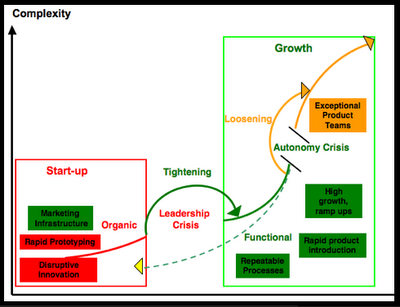
Loosen to Groom More Chiefs As a Bridge Over Autonomous Waters
Chapter Four: The Tribal Territories
By Steve Howard, CKO
The Knowledge Labs
Table of Contents
Chapter One: Basecamp
Chapter Two: The Ridge
Chapter Three: The Outpost
Chapter Four: The Tribal Territories
"In-forming is the individual's personal analog to open-sourcing, outsourcing, insourcing, supply-chaining, and offshoring. In-forming is the ability to build and deploy your own personal supply chain -- a supply chain of information, knowledge, and entertainment. In-forming is about self-collaboration -- becoming your own self-directed and self-empowered researcher, editor, and selector of entertainment, without having to go to the library or the movie theater or through network television."
Thomas L. Friedman, "The World is Flat"
DOUBLE NICKEL RANCH. As the organization grows, it becomes more complex. Loose organic states evolve into tighter functional organizations. Functional structures evolve into looser divisional structures. Divisions tighten into matrix organizations that loosen into network organizations.
Journal of 2020 Foresight: During rapid growth, if independent project team members leave, the organization will be too thin in bench strength to meet its customers’ demands, correct?
Explorer: Yes. If the organization doesn’t recruit Associates, they’ll sew the seeds of their failure.
J2020F: Failure?
Explorer: Failure to make it out of a one-product or service company category into a mature organization known as a trusted brand.
J2020F: They’ll be doomed to run in place with constant turnover, while their competitors take market share from them and with it their once loyal customers, right?
Explorer: Exactly. So the talent branding efforts shift to find the right mix of Athletes and Associates, rather than Agents and Athletes.
J2020F: What about the bonking challenge?
Explorer: The other opportunity for failure arrives during a period of strength.
J2020: How so?
Explorer: Having weathered the challenges of rapid growth, the organization plateaus with significant advantages: size, financial resources, well-developed systems, and an experienced, competent staff.
J2020F: So what’s the problem?
Explorer: Top managers find it extremely difficult to switch from directing to delegating and waiting.
J2020F: Unlike the “bridge” over the “Leadership Crisis” which required tightening, this “bridge” is about loosening?
Explorer: Yes, the 180-degree different practice favors innovation, divergence, and adaptability – approaches similar to the organic start-up stage.
J2020F: So it’s only natural that those Athletic tribal team members who ushered in the tightening functional structures would resist this “bridge.”
Explorer: Especially when they accomplished so much, but it is an old story according to Danny Miller – when a strength is overused, it becomes a weakness and maybe a fatal flaw if left unchecked.
J2020F: What happens to the Agents?
Got Knowledge?
Copyright ©2002 - 2006 Aarnaes Howard Associates. All rights reserved worldwide.
6:49 AM
Monday, August 21, 2006
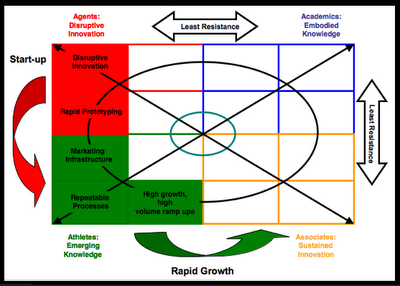
Looking Into the Eye of the Tiger or Bonking at the Border
Chapter Four: The Tribal Territories
By Steve Howard, CKO
The Knowledge Labs
Table of Contents
Chapter One: Basecamp
Chapter Two: The Ridge
Chapter Three: The Outpost
Chapter Four: The Tribal Territories
"What Google's success reflects is how much people are interested in having ... all the world's knowledge at their fingertips. There is no bigger flattener than the idea of making all the world's knowledge, or even a big chunk of it, available to anyone and everyone, anytime, anywhere."
Thomas L. Friedman, "The World is Flat"
DOUBLE NICKEL RANCH. Athletic organizations in early to growth stages can’t afford to staff up with more bodies. They contract with experts to eliminate the extra financial burden of benefits, but Athletes guard their organization’s core competencies while quickly managing increasing degrees of complexity.
Journal of 2020 Foresight: Athletes recruit Interim Managers, “Digitally Mobiles” and “Portfolio Locals” on a independent contractor basis to eliminate the extra financial burden of benefits. But, doesn't that put them in a bind? What happens if key contractors take permanent work elsewhere or become too busy on someone else's project?
Explorer: Exactly. You've described their dilemma. Project managers have to reveal just enough proprietary secrets for contractors to perform their project tasks quickly and efficiently, but not too much -- otherwise their newly learned secrets walk out the door.
J2020F: And, if the market demand explodes won't Athletes want to hire and keep key performers in the fold? Finding key people in new industries doesn't happen overnight, right?
Explorer: You are right. So, the rapid growth organization creates a “Core Business Function” for further tightening. On the path of least resistance they share a “border” with the Agile “Tiger Teams,” an Associate talent tribe that more closely resembles Athletes.
J2020F: In terms of what?
Explorer: Degree of affiliation, but less speed and more mastery. “Core Business Function” Athletes bond with their team or function primarily. “Agile Tiger Teams” develop loyalty to the team-of-teams culture -- to the organization.
J2020F: What do the “Core Business Function” Athletes tighten further?
Explorer: They develop the tools and manage the process of multiple new product introductions. They have to optimize the availability of internal and external team members – rolling people in and off of projects as the critical path for each product dictates.
J2020F: Doesn’t that “shared border” with the Associate tiger teams also define the next opportunity to bonk?
Explorer: It does, but for the opposite reason than what kept the Agents in their “start-up box” until early growth Athletes opened the garage door and stopped the “head banging.”
J2020F: How does the organization survive the crisis without a swelled head?
Got Knowledge?
Copyright ©2002 - 2006 Aarnaes Howard Associates. All rights reserved worldwide.
7:10 AM
Sunday, August 20, 2006
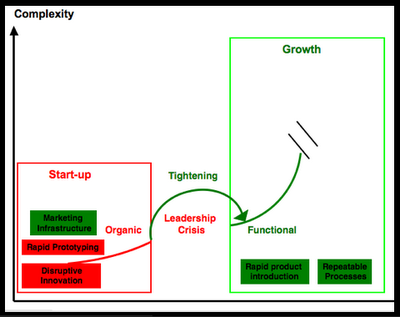
No More Head Banging: Tightening Operations Opens the Garage Door
Chapter Four: The Tribal Territories
By Steve Howard, CKO
The Knowledge Labs
Table of Contents
Chapter One: Basecamp
Chapter Two: The Ridge
Chapter Three: The Outpost
Chapter Four: The Tribal Territories
"UPS maintains a think tank ... which works on supply-chain algorithms. This "school" of mathematics is called "package flow technology," and it is designed to constantly match the deployment of UPS trucks, ships, airplanes, and sorting capabilities with that day's flow of packages around the world."
Thomas L. Friedman, “The World is Flat”
DOUBLE NICKEL RANCH. Marketing structure, repeatable processes and robust high volume ramp-ups dominate the rapid growth stage. A new set of tribal talent combinations capable of learning from their mistakes and improving their go-to-market processes grabs the baton from the Agents for the next leg of the race.
Journal of 2020 Foresight: Emerging knowledge that Athletes learn by developing "the formula" reduces the amount of the random experimenting required in each real world learning cycle, right?
Explorer: Athletes help tighten up operations by setting up functional operations. They extend, improve, and modify the central formula. At the same time they rapidly discard what doesn't fit.
J2020F: So they bring some order out of chaos necessary to handle higher growth demands?
Explorer: Yes. Breakpoint Inventors and Commercial Innovators, even with the help of Marketing Athletes can still bonk when faced with the Leadership Crisis that results from their organic, creative and collaborative organization structure.
J2020F: By standardizing procedures, policies, product lines and methods of production and distribution, Athletes – “Resilient Project Teams” -- position an organization to efficiently grow larger in its second phase, right?
Explorer: Yes. By following the path of least resistance towards the next phase of growth Athletes, more so than any other of the 12 tribal talent clusters, place a premium on emerging functional team roles.
J2020F: So in a phrase, then, Athletes select and recruit new talent based on team fit, a process focus, and an opportunistic attitude?
Explorer: Sure. Their dominant aspiration is the financial payoff traditionally associated with establishing a big company, but without all the unnecessary bureaucracy.
J2020F: They don’t want to become an Academic organization, right?
Explorer: Right. Academics move too slowly and identify with well-established professions and benchmarked practices studied at mature organizations.
J2020F: And I imagine that the Athletes who focus on tightening the organization’s business model don’t welcome the fees that Academics command and charge for their services?
Explorer: That’s true also. This stage is all about speed. Athletes harness and leverage their newfound momentum from the emerging knowledge their repeatable processes yield.
J2020F: In an earlier discussion, Trailblazer pointed out that Athletes need to guard their organization's core competencies while quickly managing and learning from increasing degrees of complexity. Can you say a little more?
Explorer: Well, Athletic organizations in early to growth stages can't afford to staff up with more bodies. As you pointed out, they have to manage their financial costs. So that means they need to become excellent project and product managers. They constantly have to ask themselves, “How much proprietary know-how should I reveal in order for contractors to complete their assigned tasks?”
J2020F: And, if they don’t yet possess those project management skills their situation might be just the opportunity Interim Managers seek who “Used to Be Somebody” under different circumstances.
Explorer: Or for the “Digitally Mobiles” and “Portfolio Locals”, as well.
J2020F: What's the right mix of talent for functional tightening given the growing complexity?
Got Knowledge?
Copyright ©2002 - 2006 Aarnaes Howard Associates. All rights reserved worldwide.
10:31 AM
Saturday, August 19, 2006
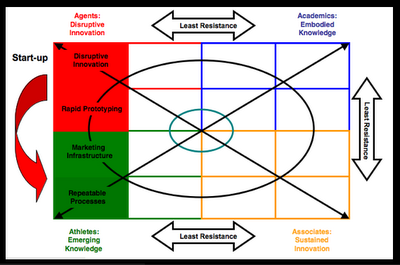
It Takes Resilient Athletes To Turn the Corner on High Growth
Chapter Four: The Tribal Territories
By Steve Howard, CKO
The Knowledge Labs
Table of Contents
Chapter One: Basecamp
Chapter Two: The Ridge
Chapter Three: The Outpost
Chapter Four: The Tribal Territories
“Then the cheerleaders all came out, but they looked different. They had camouflage outfits on, raggy, dirty camouflage. They had bandanas in camouflage and war paint on their faces. They were waving a big camouflage flag with a black monkey wrench on it. Sun looked at herself: she was dressed in camouflage, too. She had a little army hat on and a bandana around her forehead, war paint on her cheeks. The Imitators started playing and Sun picked up her megaphone.”
Neil Young & Crazy Horse “Greendale”
DOUBLE NICKEL RANCH. Critical success factors in the start-up stage are 180 degrees different from those that must be mastered to generate demand and meet that demand efficiently.
Journal of 2020 Foresight: Isn’t one of the dirty little secrets that once the enterprise becomes an enterprise – the Agent founder with the vision and unlimited faith needs to step aside.
Explorer: Yes. We call it the Leadership Crisis. The Agent founder swimming upstream all that time against the naysayers – receiving 99 “no’s” for every 1 “yes” -- needs to get out of the way for the enterprise to bridge the chasm from the start-up to emerging growth stage.
J2020F: That can’t be easy. It must be like giving your infant up for adoption.
Explorer: Except they have an exit strategy. Along the way angel investors will have insisted on more control to protect their investment then founders want to relinquish. But it takes green, as in money and as in Athletes -- “The Marketing Athletes” or the evangelists, to create demand and “Resilient Project Teams” to tighten up how operations are run.
J2020F: So, once out of the garage and across the threshold into the “next box” the founder may need to be replaced or reassigned to develop R&D strategies?
Explorer: Yes because, just the right blend of the two talent “tribes” -- Athletes and Agents --has to be optimized if the enterprise is to successfully meet the challenges of survival, stabilization and rapid growth.
J2020F: Isn’t it the Athletes – “Resilient Project Teams” who then figure out the formula for taking a prototype and turning it into a product on a repeatable basis?
Explorer: Yes, because the period of high creativity, organic and fluid organizational collaboration must give way to focused, practical execution.
J2020F: So without them, the enterprise can’t really “turn the corner” to ride the wave of accelerated growth by continuing on their path of least resistance?
Explorer: I’m sure you just broke the rule about mixed metaphors, but in essence you are right.
J2020F: Of course I am, but what about the next set of challenges?
Got Knowledge?
Copyright ©2002 - 2006 Aarnaes Howard Associates. All rights reserved worldwide.
12:40 PM
Friday, August 18, 2006
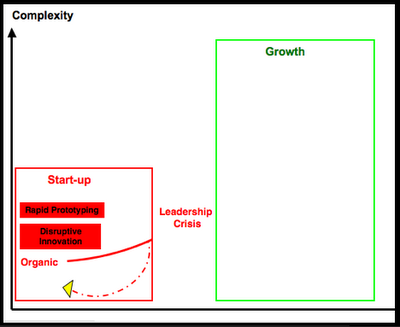
Leadership Crisis: Bonking into the Closed Garage Door
Chapter Four: The Tribal Territories
By Steve Howard, CKO
The Knowledge Labs
Table of Contents
Chapter One: Basecamp
Chapter Two: The Ridge
Chapter Three: The Outpost
Chapter Four: The Tribal Territories
“She was dreaming about a high school play…She was onstage. There was a big cardboard house on the stage, looked just like the Double E. There was a light coming out of the window where Sun’s window was. There was a yellow light coming out and it shone down on her on the stage. Grandpa was sitting on the porch in his rocking char. On the other side of the stage there was a cardboard jail. Jed was sitting there talking to Officer Carmichael. Sun’s cat walked across the stage.”
Neil Young & Crazy Horse “Greendale”
DOUBLE NICKEL RANCH. Early application breakthroughs delivered by the joint collaboration between the two start-up Agent talent tribes -- “Breakpoint Inventors” and “Commercial Innovators” -- generate the dramatic competitive advantage that visionaries seek.
J2020F: But, it’s not all downhill from there, right?
Explorer: Unless you count falling into the chasm between start-up and early growth stages the kind of downhill you favor.
J2020F: Not hardly. What’s the typical scenario for the “garage start-ups”?
Explorer: Theirs is a tricky proposition. If they come up with a discontinuous technology whose sole benefit is to lower cost and improve productivity within a well-worn application arena, they have essentially an unmarketable opportunity.
J2020F: Why?
Explorer: The reason is that conservative consumers – the mass market -- simply will not tolerate “paradigm shock,” nor will they invest in helping vendors reduce that shock over time.
J2020F: They follow the herd and won’t abandon a tried and true approach, right? Buzz equates to career or customer risk in their minds?
Explorer: Right. The conservatives only buy into a new technology after the pragmatists, who in turn only buy new technology when it can give them significant breakthroughs in workflows, have vetted it.
J2020F: So, not every start-up makes it to the next stage.
Explorer: The longer it takes to convert visionary influence into early pragmatist orders tests the start-up’s capacity for survival.
J2020F: It has to generate enough cash initially, and then stabilize its business by eliminating cash flow problems?
Explorer: And that my friend is the crux of the problem. Meeting the challenge we’ve described is typically not the strong suit of the Agent tribes.
J2020F: So the start-up bonks? It can’t get out of the “garage”; it hits the closed garage door?
Explorer: Yes in the vast majority of the cases. Most of the time the start-up doesn’t find a market niche or can’t produce a viable product of service. But, it can still bonk when the fiercely independent “chief” fails to relinquish control and sets up the “Leadership Crisis.”
J2020F: What do enlightened chiefs do to bridge the crisis?
Got Knowledge?
Copyright ©2002 - 2006 Aarnaes Howard Associates. All rights reserved worldwide.
7:20 AM
Thursday, August 17, 2006

Start-up Tribes: Breakpoint Inventors and Commercial Innovators
Chapter Four: The Tribal Territories
By Steve Howard, CKO
The Knowledge Labs
Table of Contents
Chapter One: Basecamp
Chapter Two: The Ridge
Chapter Three: The Outpost
Chapter Four: The Tribal Territories
“There was a strange red glow in the back. He noticed it, but he forgot about it so fast. He though he heard a noise in the engine, though … the engine was making funny sounds. The windshield wipers weren’t working right. They were flying up on Highway 1. Earth was sweating. Sun was peacefully asleep, with her head resting on his shoulder, not a care in the world. She was dreaming.”
Neil Young & Crazy Horse “Greendale”
DOUBLE NICKEL RANCH. In the start-up phase those “Breakpoint Inventors” and entrepreneurs with a new disruptive innovation need people, “Commercial Innovators,” capable of defining and delivering a rapid prototype of the new product category.
Journal of 2020 Foresight: Triggering the path of least resistance, Agent tribes (whom Trailblazer called the “Para-doxy Morons”) look at a well-established, mature market from an offbeat perspective and notice how limited a traditional business model, branch of science, innovation, technology or business model solves a really complex set of problems.
Explorer: What we used to call an AGENT-Agent tribe catalyzes disruptive innovation. “The Breakpoint Inventor” (our newer name) excels at going from 0 to 1. But, it takes somebody else to go from 1 to 1000.
J2020F: And, other tribal combinations, if they survive, to fill in the white space – the blanks on our chart?
Explorer: Yes. They need to turn to the correct combination to manage the “crises at the border” between stages.
J2020F: If they turn to a standalone organization, that someone would have a blend of Agent and Athlete in them – the “Commercial Innovator.”
Explorer: That’s right. And, we’ll see later that they’ll need “more of the green” – more Athletic Tribal members to move the start-up out of its formative stage “box.”
J2020F: Why? Is it that in early survival mode Agents love to find out, in the most creative and inventive way, how to operate and structure their fledgling enterprise– which may not be even clearly defined at the earliest stage?
Explorer: That’s the major reason. This is an organic, entrepreneurial faith driven stage. We all witnessed celebrated cases – during the dot-com meltdown, where high tech organizations populated with a small core of agents discovered to their dismay that the "paradigm shock" associated with their disruptive innovation was too high and the benefit was too low.
J2020F: Why?
Explorer: Typically because applications for the new technology hadn’t been proven – beyond their “new economy cool factor”. This stage, populated by the two types of agents – Breakpoint Inventors and Commercial Innovators -- is the realm of pure science, buggy technology and prototypes.
J2020F: Geeks and nerds only? The ones who thrive on technology-driven speed and independence?
Explorer: While politically incorrect, there is some truth to the stereotype. Only technology enthusiasts are interested. Here’s the rub. Their market niche emerges too slowly for them. In the early stage it is built up around one or more visionaries who see the potential for the new technology and fund the first proofs-of-concept.
J2020F: They evangelize to their trusted circle of friends and opinion makers and entice them to view what they’ve discovered, right?
Explorer: That’s the buzz building stage. It infects early adopters with a compelling vision of the future. The adrenalin rush transfers to the adopters and entices them to join in the organic web of insiders who know about and have to have the newest and greatest.
J2020F: That's how it is suppose to proceed in theory, but what happens more often then not to the "Garage Entrepreneurs?"
Got Knowledge?
Copyright ©2002 - 2006 Aarnaes Howard Associates. All rights reserved worldwide.
6:55 AM
Wednesday, August 16, 2006
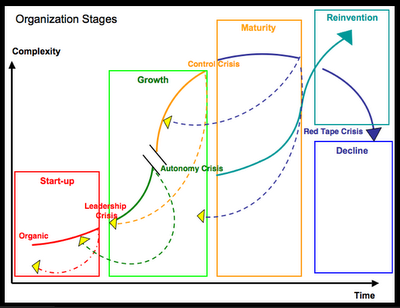
Talented Crisis Management: Leadership, Autonomy, Control, and Red Tape
Chapter Four: The Tribal Territories
By Steve Howard, CKO
The Knowledge Labs
Table of Contents
Chapter One: Basecamp
Chapter Two: The Ridge
Chapter Three: The Outpost
Chapter Four: The Tribal Territories
“So Sun met Earth Brown in John Lee’s bar. Earth was fascinated and captivated by her beauty, the symmetry of her moves. He couldn’t take his eyes off her. While he was watching her, the Devil came up behind him. He saw that Earth was drinking some Alaska water, from the glaciers.”
Neil Young & Crazy Horse “Greendale”
DOUBLE NICKEL RANCH. If you consider the lifespan of an organization that has any sort of history – say over two generations or 40 years -- you can see which talent competencies come in and out of favor. You’ll witness it as it evolves and leaps forward in predictable stages from infancy start-up through growth to maturity and decline and from simple to complex over time.
Journal of 2020 Foresight: Not all organizations even make it that far -- 40 years, right?
Explorer: The infant mortality rate is a decade. To your point, Arie De Geus says 40% of all newly created companies don’t last that long. Regardless of size, the average in Japan and Europe is 12.5 years.
J2020F: So hanging on to the wrong talent combinations at the wrong stage accelerates the decline?
Explorer: You bet. And, by not attracting, developing and retaining new talent to move from one growth stage to another stage dramatically shortens an organization’s life expectancy.
J2020F: But, it isn’t simply cloning what you already have is it?
Explorer: Each stage presents unique challenges that require specific talent combinations to meet. Because each new stage – on the other side of a threshold -- requires a different and opposite formula for success.
J2020F: The organization requires a different and opposite talent combination to succeed.
Explorer: And, so Boomer leaders must consciously introduce planned structures that are 180 degrees different than what worked in the recent past to move the organization’s performance ahead.
J2020F: If they don’t plan to introduce those changes with a little foresight, then they can expect to travel the path of highest resistance to their initiatives, right?
Explorer: Yes, and even if they follow the path of least resistance they will still encounter disruption. But, they will be able to learn and grow through the experience without as much fear, uncertainty or doubt about their future viability -- or as severe an impact on revenues, profits or market share.
J2020F: Take us through the “make or break” crisis sequence.
Explorer: Briefly the start-up stage sets up the first crisis – “The Leadership Crisis.” You won’t survive if you don’t change the talent balance. The second, the “Autonomy Crisis” signals when the organization must shift talent combinations again or it won’t survive the turning point from hyper growth to stable growth.
J2020F: If the organization survives those disruptive turning points?
Explorer: It must negotiate the final two crises, the “Control Crisis” which resolves the “Autonomy Crisis,” but eventually triggers the near death “Red Tape Crisis” that precedes the Decline stage.
J2020F: If you don’t bridge the gap between stages (boxes), then what?
Explorer: You bonk.
J2020F: You what?
Explorer: You hit the wall and bounce back only to repeat the same or an earlier stage over and over again until you get it right.
J2020F: Which might be why you are interviewing for an executive opening. They’ve been bonking when they should have been managing stage transitions.
Explorer: And, as you launch your 100-day initiative you’ll need to assess the talent you’ve inherited to figure out if you’ve got the right blend to be successful.
J2020F: Are all four Agent clusters necessary to organically start an organization from scratch?
Got Knowledge?
Copyright ©2002 - 2006 Aarnaes Howard Associates. All rights reserved worldwide.
6:22 AM
Tuesday, August 15, 2006
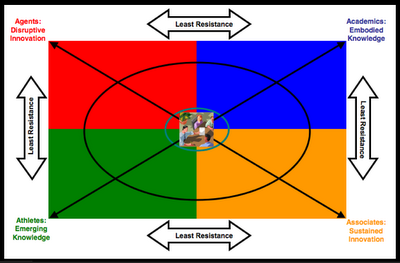
Circling the Borders for the Path of Least Resistance
Chapter Four: The Tribal Territories
By Steve Howard, CKO
The Knowledge Labs
Table of Contents
Chapter One: Basecamp
Chapter Two: The Ridge
Chapter Three: The Outpost
Chapter Four: The Tribal Territories
“He started thinking too much, second-guessing. Nothing happened that he didn’t question and then question again. His thirst was overwhelming. He and Sun were in the Alaskan camper, headed north on Highway 1 to Alaska. Earth stopped at a convenience store and bought several cartons of water. He kept about a dozen bottles in the front seat and put the rest of it in the back.”
Neil Young & Crazy Horse “Greendale”
DOUBLE NICKEL RANCH. The talent model reveals several ways that Baby Boomer leaders, job-seekers, entrepreneurs or consultants can first diagnose issues that hinder growth and then provide solutions that stimulate success at each organizational lifespan.
Journal of 2020 Foresight: The path of highest resistance in your model follows the arrows from corner to corner moving in both ways through the center.
Explorer: That’s right.
J2020F: How can you use the talent model to find a path of least resistance to your initiatives and goals?
Explorer: Picture the model as a chessboard. We move around the borders. Boomer leaders, when introducing new changes, follow this path of revitalization as opposed to resistance, renewal, restructuring or realignment.
J2020F: So the path of least resistance for changing talent cultures is from disruptive innovation to emerging knowledge?
Explorer: Yes from the Agent to the Athlete quadrant.
J2020F: And from emerging knowledge to sustained innovation?
Explorer: Yes, from Athlete to Associate.
J2020F: And from sustained innovation to embodied knowledge?
Explorer: Yes, from Associate to Academic.
J2020F: And, let me guess. From embodied knowledge to disruptive innovation – or from Associate to Agent! If I'm a new executive, how can I take advantage of this model for talent management? Is there anything else I need to know?
Got Knowledge?
Copyright ©2002 - 2006 Aarnaes Howard Associates. All rights reserved worldwide.
6:50 AM
|
|
| |
|
|
|